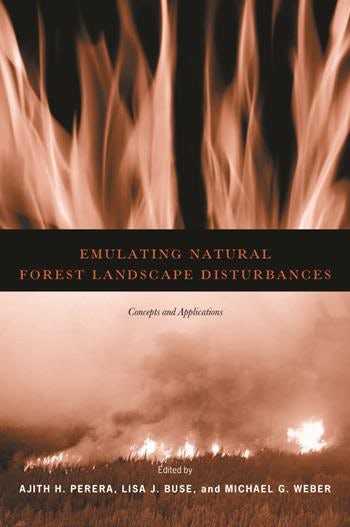What is a natural forest disturbance? How well do we understand natural forest disturbances and how might we emulate them in forest management? What role does emulation play in forest management? Representing a range of geographic perspectives from across Canada and the United States, this book looks at the escalating public debate on the viability of natural disturbance emulation for sustaining forest landscapes from the perspective of policymakers, forestry professionals, academics, and conservationists.
This book provides a scientific foundation for justifying the use of and a solid framework for examining the ambiguities inherent in emulating natural forest landscape disturbance. It acknowledges the divergent expectations that practitioners face and offers a balanced view of the promises and challenges associated with applying this emerging forest management paradigm.
The first section examines foundational concepts, addressing questions of what emulation involves and what ecological reasoning substantiates it. These include a broad overview, a detailed review of emerging forest management paradigms and their global context, and an examination of the ecological premise for emulating natural disturbance. This section also explores the current understanding of natural disturbance regimes, including the two most prevalent in North America: fire and insects.
The second section uses case studies from a wide geographical range to address the characterization of natural disturbances and the development of applied templates for their emulation through forest management. The emphasis on fire regimes in this section reflects the greater focus that has traditionally been placed on understanding and managing fire, compared with other forms of disturbance, and utilizes several viewpoints to address the lessons learned from historical disturbance patterns.
Reflecting on current thinking in the field, immediate challenges, and potential directions, the final section moves deeper into the issues of practical applications by exploring the expectations for and feasibility of emulating natural disturbance through forest management.
- Contents
- Contributors
- List of Figures and Tables
- Preface
- Acknowledgments
- PART I Concepts
- 1 Emulating Natural Disturbance in Forest Management: An Overview
- 2 Emulating Natural Forest Disturbance: What Does This Mean?
- 3 The Ecological and Genetic Basis for Emulating Natural Disturbances in Forest Management: Theory Guiding Practice
- 4 Characterizing Natural Forest Disturbance Regimes: Concepts and Approaches
- 5 Predicting Fire Regimes at Multiple Scales
- 6 Predicting Forest Insect Disturbance Regimes for Use in Emulating Natural Disturbance
- PART II Applications: Understanding Forest Disturbances
- 7 Empirical Approaches to Modeling Wildland Fire in the Pacific Northwest Region of the United States
- 8 Simulating Forest Fire Regimes in the Foothills of the Canadian Rocky Mountains
- 9 Spatial Simulation of Broad-Scale Fire Regimes as a Tool for Emulating Natural Forest Landscape Disturbance
- 10 Simulating the Effects of Forest Fire and Timber Harvesting on the Hardwood Species of Central Missouri
- 11 Using Insect-Caused Patterns of Disturbance in Northern New Brunswick to Inform Forest Management
- 12 Using Criteria Based on the Natural Fire Regime to Evaluate Forest Management in the Oregon Coast Range of the United States
- 13 Using a Decision to Support System to Estimate Departures of Present Forest Landscape Patterns from Historical Reference Conditions
- 14 Changes in Tree Species Composition from Pre-European Settlement to Present: A Case Study of the Temagami Forest, Ontario
- PART III Applications: Perspectives, Practices, and Policy
- 15 A Conservation Perspective on Emulating Natural Disturbance in the Management of Boreal Forests in Ontario
- 16 Consequences of Emulating Natural Forest Disturbance: A Canadian Forest Industry Perspective
- 17 An Economic Perspective on Emulation Forestry and a Case Study on Woodland Caribou–Wood Production Trade-Offs in Northern Ontario
- 18 Developing Forest Management Strategies Based on Fire Regimes in Northwestern Quebec
- 19 Emulating Natural Forest Disturbance: Applications for Silvicultural Systems in the Northern Great Lakes Region of the United States
- 20 Emulating Natural Forest Disturbance in the Wildland–Urban Interface of the Greater Yellowstone Ecosystem of the United States
- 21 Emulating Natural Forest Disturbance: From Policy to Practical Guidance in Ontario
- PART IV Conclusion
- 22 Emulating Natural Forest Landscape Disturbances: A Synthesis
- References
- Index

